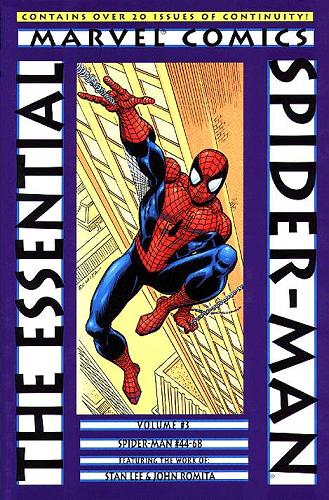
Essential Spider-Man Vol. 3
Stan Lee, John Romita and friends
Reprints: Amazing Spider-Man #44-68 (January 1967 – January 1969)
Get this for: Lee & Romita on Spider-Man– four stars
After finishing off the Lee-Ditko run on Amazing Spider-Man with Essential Spider-Man Vol 2 yesterday, I thought I’d give the Romita run a try as well with Essential Spider-Man Vol 3, containing exactly two years of continuity. This is the period in which the foundations for the Spider-Man I grew up with were laid. There’s more soap opera, it’s taken more serious and some of the humour of the Ditko issues has gone. Where earlier Spidey’s troubles rarely lasted much beyond one issue, from now on he would barely be able to keep going with all the issues and hangups put on him. You can see the first glimmers of Bronze Age Marvel here, with its emphasis on shared continuity, large supporting casts and long running subplots. It all feels familiar to me in a way the Ditko issues did not.
On the art front, while it is clear to see the Ditko influences in Romita’s work here, his work is much more conventionally pretty and as he had cut his teeth on romance comics, his women are drop dead gorgeous in a way Ditko never could match. His male characters too are much more handsome than they were before. While stylistically I prefer Ditko over Romita — his fights were never as exciting as Ditko’s — his clear, clean artwork did provide Spider-Man with his definitive look, a reference point for every artist that came after him on Spider-Man.
What struck me reading this volume was that some of the momentum was gone; things seem more static, though Petey does finally move out from Aunt May’s house into a shared apartment with Harry Osborn and moves to college. There are fewer new villains (the Shocker and Kingpin being the exception) and more old ones making re-appearances, like Doctor Octopus, Mysterio and the Vulture. The stories aren’t bad by any means, but none have the impact of e.g. the Master Planner arc from the previous volume.
Spidey gets a lot more hip and happening too as Romita comes along, getting so sixties it’s almost embarassing. Lots of fun though. One big but subtle improvement castwise is the addition of Joe and Randy Robertson to the cast, the first regular Black supporting characters in comics. Or at least the first ones not to be embarassing racial stereotypes at least. No fuzz is made about them being Black either: Joe is introduced as the Bugle‘s new city editor, Randy as a fellow student of Peter’s at E.S.U.
The Lee – Romita Spider-Man is very different from the Ditko – Lee version, but almost as good. Reading these stories is not as exciting as reading the Ditko ones, but they do feel mighty comfortable, like taking in a nice hot bath. That’s not bad either.